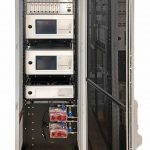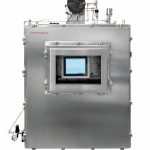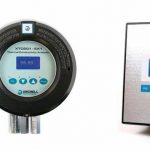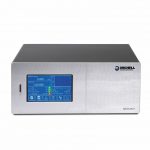The accurate determination of trace impurities in hydrogen is a key issue for the chemical industry, because purity in material-converting processes is not only relevant for gas quality, but also for process safety. For example, ultra-high-purity (UHP) hydrogen according to ISO 14687 Part 2 is required for fuel cells in order to achieve the longest possible service life of the electrolyte and catalysts. The same applies to specialty gases used in the manufacture of semiconductors. Even trace impurities in parts per billion (ppb) lead to the loss of entire batches.
Hydrogen production
Hydrogen producers and users must therefore ensure that the quality of the hydrogen meets the required specifications. Currently, hydrogen is mainly produced from natural gas by steam methane reforming (SMR). The disadvantage of this so-called „grey“ hydrogen is that a large amount of carbon dioxide is produced when methane (CH4) is broken down into its molecules. However, the steam reforming process is also suitable for producing hydrogen from biomethane. This has the advantage that fewer harmful by-products are produced.
In comparison, electrical energy from renewable sources such as wind and solar energy is used to produce „green“ hydrogen, which is obtained via the electrolysis of water. The French start-up company Lhyfe, which specialises in green hydrogen, is demonstrating what such an energy supply for green hydrogen production via electrolysis could look like with various projects in France and Denmark. One example is the planned electrolysis plant with a capacity of 24 MW at the Greenlab industrial park in Denmark. The direct connection of the planned production facilities with renewable energy from wind power enables the production of 100 % CO2-neutral green hydrogen.
Measurement of trace contamination
Process Sensing Technologies (PST) offers a comprehensive range of instruments and analysers for precision measurements in industrial process control, environmental monitoring and food/pharmaceutical processing. Among other things, they monitor processes for hydrogen production such as methane steam reforming, hydrogen generators or green hydrogen produced by electrolysis. They also provide protection against contamination from moisture. For trace contamination measurements in hydrogen according to ISO 14687, the Hydetek all-in-one gas chromatography (GC) system is the ideal solution. This is because trace impurities in hydrogen in particular involve the detection of extremely low concentrations that have to be measured individually.
The Hydetek system measures impurities in the ppb/ppm range of nitrogen, argon, methane, carbon monoxide, carbon dioxide, non-methane hydrocarbons (NMHC), sulfur, formaldehyde, ammonia, halogenated formic acid and water. Applications range from the analysis of trace contaminants to the determination of the purity of hydrogen at measurement points to measurements of synthesis gas composition. A total of up to 16 currents can be set and different combinations of detectors can be integrated to cover the complete spectrum: for example, a plasma emission detector (PED), a thermal conductivity detector (TCD) and a sensor for measuring trace moisture. A flame ionisation detector (FID) is also available. Since all modules are mounted in the same analyser cabinet, the company can offer the complete range of analyses from a single source. With individual instruments, this would be very cost-intensive, especially in the ppm range.
Plasma emission detector (PED)
PEDs use the principle of spectroscopic emission in a compact measuring cell and are used to perform multiple measurements with a single detection module. In addition, they usually work with alternative carrier gases. The microprocessor-controlled Plasmadetek 2 PED system has been specially developed for GC system integrators and manufacturers as well as end users and, thanks to plug-and-play, allows installation in any gas chromatography system. It uses either argon or helium as the carrier gas and is designed to measure organic and inorganic compounds as well as permanent gases and noble gases, including neon – from ppb to % detection using capillary or packed columns. Thanks to argon as a carrier gas, operating costs can be reduced by a factor of 4 to 5 compared to most stand-alone instruments that use only helium.
Such a Hydetek system also operates in the world’s largest proton exchange membrane (PEM) electrolysis plant in Quebec (Canada). The integrated PEDs here have the task of using selective optical filters to detect possible traces of oxygen, nitrogen and carbon dioxide in the hydrogen produced. These elements are among the most important impurities that must be monitored and measured in the hydrogen produced by electrolysis of water.
Thermal conductivity and humidity
The thermal conductivity detector (TCD) is also a central detector in gas chromatography. It is mainly used for the detection or quantification of inorganic gases such as argon, nitrogen, hydrogen and carbon dioxide and measures the difference in thermal conductivity of the sample gas stream compared to a carrier gas as a reference.
A quartz oscillating analyzer (QMA401) is available for additional measurement of the trace moisture content. It can also be integrated into the GC online measurement with the Hydetek. The oscillating quartz analyser is designed to provide reliable, fast and accurate measurement of trace moisture in applications where it is critical to keep this value to a minimum. The instrument consistently provides very accurate trace moisture measurements in the range of 0.1 to 2,000 ppmv. This is achieved by a self-calibration system that adjusts the sensor with reference to an internal humidity generator.
Conclusion
With the Hydetek system, Process Sensing Technologies offers the user an all-in-one solution from a single source. Different combinations of detectors such as PED, TCD and FID, together with a high-precision moisture measurement via an oscillating crystal, enable the analysis of a wide range of possible trace impurities in hydrogen. If required, the Multidetek 2 Ex is also available as a purged version in a certified stainless-steel housing for use in hazardous areas of zones 1 and 2.
PST – Michell Instruments GmbH, Friedrichsdorf













